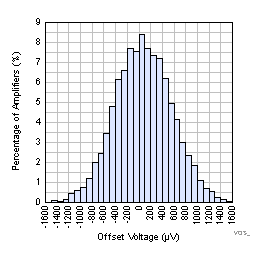SNOSD29E December 2016 – April 2018 TLV8541 , TLV8542 , TLV8544
UNLESS OTHERWISE NOTED, this document contains PRODUCTION DATA.
- 1 Features
- 2 Applications
- 3 Description
- 4 Revision History
- 5 Description (continued)
- 6 Pin Configuration and Functions
- 7 Specifications
- 8 Detailed Description
- 9 Application and Implementation
- 10Power Supply Recommendations
- 11Layout
- 12Device and Documentation Support
- 13Mechanical, Packaging, and Orderable Information
Package Options
Mechanical Data (Package|Pins)
- DBV|5
Thermal pad, mechanical data (Package|Pins)
Orderable Information
7.6 Typical Characteristics
TA = 25°C, RL = 10 MΩ to VS/2 ,CL = 20 pF, VCM = VS / 2 V unless otherwise specified.
| VS = 1.8 V | VCM = V+ | Data from 1500 4-channel devices |

| VS = 3.3 V | VCM = V+ | Data from 1500 4-channel devices |

| VS = 1.8 V | TA = –40, 25, 125°C | Per Channel |

| VS = 1.8 V | TA = –40, 25, 125°C | |

| VS = 1.6 to 3.6V | TA = –40, 25, 125°C | VCM = V- |

| VS= 3.3V | TA = 25°C | VCM = V– |

| VS = 3.3 V | TA = –40, 25, 125°C | |

| VS = 3.3 V | TA = –40, 25, 125°C | |

| VS = 3.3 V | TA = –40°C | |

| VS = 3.3 V | TA = 25°C | |

| VS = 3.3 V | TA = 125°C | |

| VS = 3.3 V | TA = 25°C | |

| VS = 3.3 V | TA = 25°C | |
| AV = 1 |

| VS = 3.3 V | TA = 25 °C | CL = 50 pF |
| VIN = 1.65 ± 0.1 V | AV = 1 |

| VS = 3.3 V | TA = 25°C | CL = 50 pF |
| VIN = 1.65 ± 1 V | AV = 1 |

| VS = 1.8 V | VCM = V– | Data from 1500 4-channel devices |

| VS = 3.3 V | VCM = V– | Data from 1500 4-channel devices |

| VS = 3.3 V | TA = –40, 25, 125°C | Per Channel |

| VS = 3.3 V | TA = –40, 25, 125°C | |

| VS= 3.3V | TA = 25°C | |

| VS = 1.8 V | TA = –40, 25, 125°C | |

| VS = 1.8 V | TA = –40, 25, 125°C | |

| VS = 1.8 V | TA = –40°C | |

| VS = 1.8 V | TA = 25°C | |

| VS= 1.8V | TA = 125°C | |

| VS = 3.3 V | TA = –40, 25, 125°C | CL = 50 pF |

| VS = 3.3 V | TA = 25°C | |

| VS = 1.8 V | TA = 25°C | CL = 50 pF |
| VIN = 0.9 ± 0.1 V | AV = 1 |

| VS = 1.8 V | TA = 25°C | CL = 50 pF |
| VIN = 0.9 ± 0.5 V | AV = 1 |